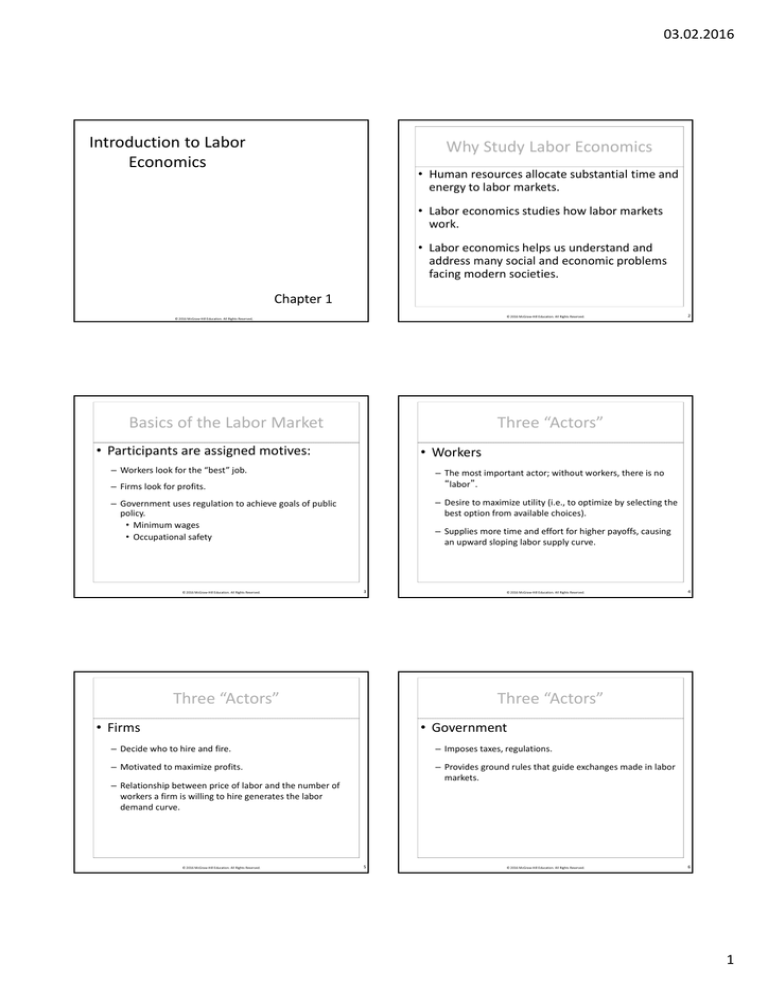
03.02.2016
Introduction to Labor Economics
Why Study Labor Economics
• Human resources allocate substantial time and energy to labor markets.
• Labor economics studies how labor markets work.
• Labor economics helps us understand and address many social and economic problems facing modern societies.
Chapter 1
© 2016 McGraw‐Hill Education. All Rights Reserved.
© 2016 McGraw‐Hill Education. All Rights Reserved,
Basics of the Labor Market
Three “Actors”
• Participants are assigned motives:
• Workers
– Workers look for the “best” job.
– The most important actor; without workers, there is no “labor”.
– Firms look for profits.
– Desire to maximize utility (i.e., to optimize by selecting the best option from available choices).
– Government uses regulation to achieve goals of public policy.
• Minimum wages
• Occupational safety
© 2016 McGraw‐Hill Education. All Rights Reserved.
2
– Supplies more time and effort for higher payoffs, causing an upward sloping labor supply curve.
3
Three “Actors”
© 2016 McGraw‐Hill Education. All Rights Reserved.
4
Three “Actors”
• Firms
• Government
– Decide who to hire and fire.
– Imposes taxes, regulations.
– Motivated to maximize profits.
– Provides ground rules that guide exchanges made in labor markets.
– Relationship between price of labor and the number of workers a firm is willing to hire generates the labor demand curve.
© 2016 McGraw‐Hill Education. All Rights Reserved.
5
© 2016 McGraw‐Hill Education. All Rights Reserved.
6
1
03.02.2016
Why Do We Need a Theory
Positive vs. Normative Economics
• Positive economics
• Explain and understand how labor markets work.
– Addresses the facts
– Focus on “what is”
– Questions answered with the tools of economists
• Focus on the essential variables while leaving out other, less crucial, factors.
• Normative economics
– Addresses values
– Focus on “what should be”
– Requires judgments
• Create a model that helps explain the theory.
7
© 2016 McGraw‐Hill Education. All Rights Reserved.
Supply and Demand in the Engineering Labor Market
8
© 2016 McGraw‐Hill Education. All Rights Reserved.
The Alaskan Labor Market and Construction of the Oil Pipeline
Earnings ($)
Earnings ($)
Labor Supply
Curve
S0
50,000
w1
Equilibrium
40,000
w0
Labor Demand
Curve
30,000
D1
D0
10,000
20,000
30,000
Employment
Employment
E0
© 2016 McGraw‐Hill Education. All Rights Reserved.
9
Wages and Employment in the Alaskan Labor Market, 1968‐1984
E1
© 2016 McGraw‐Hill Education. All Rights Reserved.
10
Summary
• Labor economics studies how labor markets work.
• Models in labor economics typically contain three actors: workers, firms, and governments.
• A good theory should have realistic assumptions and can be tested with real‐world data.
• The tools of economics are helpful in answering positive questions.
© 2016 McGraw‐Hill Education. All Rights Reserved.
11
© 2016 McGraw‐Hill Education. All Rights Reserved.
12
2
03.02.2016
Where Are We Going?
•
•
•
•
•
•
•
•
•
•
Appendix: Regression Analysis
Worker supply decisions
Firm demand decisions
Labor market equilibrium
Differences in job characteristics
Differences in worker characteristics
Labor mobility
Labor marker discrimination
Unionization
Incentive pay schemes
Unemployment
© 2016 McGraw‐Hill Education. All Rights Reserved.
Log Wage
Change in log
wage
Slope =
Change in
schooling
13
Scatter Diagram: Wages and Schooling by Occupation, 2001
© 2016 McGraw‐Hill Education. All Rights Reserved.
Years of Schooling
© 2016 McGraw‐Hill Education. All Rights Reserved.
14
Choosing Among Lines Summarizing Trends in Data
15
The Best‐Fit Regression Line
© 2016 McGraw‐Hill Education. All Rights Reserved.
16
Multiple Regression
• Extending regression analysis to include multiple independent variables
• Each estimated coefficient shows the impact of a particular variable on the dependent variable, other things constant
• Standard errors of the regression coefficients are used to evaluate significance of the relations between each particular variable and the dependent variable
© 2016 McGraw‐Hill Education. All Rights Reserved.
17
© 2016 McGraw‐Hill Education. All Rights Reserved.
18
3



